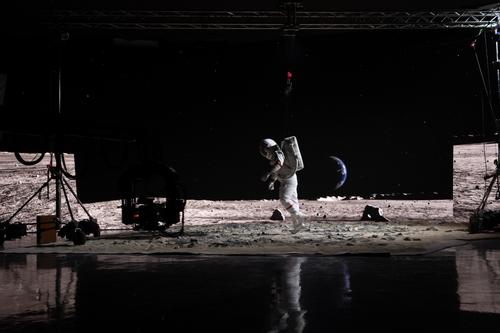What is a jib camera?
A jib camera is simply a camera mounted on a jib, which is a boom or crane device. On the other end of the jib, there’s a counterweight and either manual or automatic controls to direct the position of the camera. The main benefit of using a jib is that it allows camera operators to get shots that would otherwise be difficult to obtain due to obstacles or awkward positions.
Different types of jib
Jibs come in many sizes; from small jibs for handheld cameras to enormous booms that can pan over the heads of huge festival crowds. Regardless of the size, however, the purpose remains the same. A camera jib is there to help provide producers with stable crane shots.
What is a crane shot?
A crane shot is shot taken from a jib camera. Whilst most jibs can move in all directions, they’re valued primarily for their ability to move on a vertical plane. This gives producers the opportunity to emphasise the scale of a set, and is often used either to introduce or close a setting in a film.
Crane shot examples
La La Land (2017)
The opening scene of Damien Chazelle’s Oscar-nominated La La Land was shot with the use of a camera jib. The scene presented various challenges to camera technicians as the shot weaves around stationary cars and dancers. An added complication was that the freeway it was filmed on was actually slanted, creating panning perspective problems. Regardless, the end result was a success – the scene set the tone for the rest of the film whilst introducing Los Angeles, the central location of the narrative.
Once Upon a Time in Hollywood (2019)
Quentin Tarrantino is well-known for his use of jibs for panoramic and tracking shots. Most recently, he used them in Once Upon a Time in Hollywood (2019) to place characters in context and add atmosphere. At the end of the ‘Rick’s house’ scene, a large jib camera slowly pans out from across the top of a Hollywood home to reveal the neighbourhood’s quiet night time roads.
Camera heads for jibs
To achieve shots like these, operators need to be able to move and adjust the camera at the end of the jib. This can be done either manually through a series of pull-wheels, or automatically with a controller. Either way allows operators to pan, tilt, and zoom the camera.
Camera jibs for virtual production
Jibs used for virtual production either need to have all axes encoded, or have a tracking system attached to them. This is required in order to capture camera movement data in order that the virtual elements of a shot can be made to move in exactly the same way as the real camera shot. When it comes to virtual production, which jib you decide to use is extremely important. This is because any unintended movement (i.e. any unencoded or untracked movement) caused by the jib can cause virtual images to ‘float’ and break the illusion. To counter this, VP jibs need to be heavier, sturdier, and more rigid. Mo-Sys’s e-Crane and Robojib were designed specifically with these needs in mind – catering to a growing trend in Virtual Production (VP), Extended reality (XR), and augmented reality (AR).
Mo-Sys Academy is committed to sharing the latest developments in film and broadcasting technology with those looking to enter the field. If you’re interested in learning more, check out our previous articles explaining what a film crew does, and the difference between AR and VR broadcasting.




